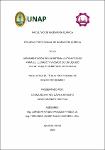| dc.contributor.advisor | Vásquez Pinedo, Jorge Armando | |
| dc.contributor.advisor | Salas Barrera, Fernando Javier | |
| dc.contributor.author | Dávila Rengifo, Leonardo Mykel | |
| dc.contributor.author | Grández Noriega, David | |
| dc.date.accessioned | 2024-08-16T12:35:45Z | |
| dc.date.available | 2024-08-16T12:35:45Z | |
| dc.date.issued | 2024 | |
| dc.identifier.other | 629.89 D19 2024 | |
| dc.identifier.uri | https://hdl.handle.net/20.500.12737/10364 | |
| dc.description.abstract | The general objective of the present thesis was: implementing a system automated for the filling and draining of a liquid in a cylindrical horizontal tank; determining firstly the relation between the volume with the level of liquid, which made suitable itself and programmed in Microsoft Excel 2023 to determine the initial volume and the experimental value of the final volume of liquid. The implementation of the automated system was the following: a programmable relay, two push-buttons NC, two push-buttons NO, two lights led, a thermic key with its bipolar plug, a viewfinder with gauged rule, a line filling (shaped for spans of piping and accessories, the electric pumps filling and a meter of volume) and a line draining (shaped for spans of piping and accessories, the electric pumps draining and a meter of volume). Straightaway, became elaborate the diagram ladder for the automatic control of the filling and draining of a liquid in a cylindrical horizontal tank, which allowed determining the number of inputs and physical outputs that were used of the programmable relay, the same that gave results: four inputs and two physical outputs. At last, five (5) proofs for the filling and five (5) for the draining came true. The minimum (0.205 %) and maximum (1.384 %) percentage error regarding the final volume of liquid, they obtained in the proofs 4 and 5 of the operation of draining, respectively. The present thesis has this way been culminated, coming true with the objective general and the time trying on his general hypothesis. | en_US |
| dc.description.abstract | El objetivo general de la presente tesis fue: implementar un sistema automatizado para el llenado y vaciado de un líquido en un tanque cilíndrico horizontal; determinándose primeramente la relación entre el volumen con el nivel de líquido, la cual se adecuó y programó en Microsoft Excel 2023 para determinar el volumen inicial y el valor experimental del volumen final de líquido. La implementación del sistema automatizado fue la siguiente: un relé programable, dos pulsadores NC, dos pulsadores NA, dos luces led, una llave térmica con su enchufe bipolar, un visor con regla graduada, una línea de llenado (conformada por tramos de tubería y accesorios, la electrobomba de llenado y un contador de volumen) y una línea de vaciado (conformada por tramos de tubería y accesorios, la electrobomba de vaciado y un contador de volumen). Seguidamente, se elaboró el diagrama ladder para el control automático del llenado y vaciado de un líquido en un tanque cilíndrico horizontal, lo cual permitió determinar el número de entradas y salidas físicas que se utilizaron del relé programable, las mismas que resultaron: cuatro entradas y dos salidas físicas. Finalmente, se realizaron cinco (5) pruebas para el llenado y cinco (5) para el vaciado. El mínimo (0.205 %) y máximo (1.384 %) error porcentual con respecto al volumen final de líquido, se obtuvo en las pruebas 4 y 5 de la operación de vaciado, respectivamente. De esta manera se ha culminado la presente tesis, cumpliéndose con el objetivo general y la vez probándose la hipótesis general. | es_PE |
| dc.format | application/pdf | es_PE |
| dc.language.iso | spa | es_PE |
| dc.publisher | Universidad Nacional de la Amazonía Peruana | es_PE |
| dc.rights | info:eu-repo/semantics/openAccess | * |
| dc.rights.uri | https://creativecommons.org/licenses/by/4.0/ | * |
| dc.subject | Control automático | es_PE |
| dc.subject | Controladores programables | es_PE |
| dc.subject | Mecánica de fluidos | es_PE |
| dc.subject | Tanque de almacenamiento | es_PE |
| dc.title | Implementación de un sistema automatizado para el llenado y vaciado de un líquido en un tanque cilíndrico horizontal | es_PE |
| dc.type | info:eu-repo/semantics/bachelorThesis | es_PE |
| thesis.degree.discipline | Ingeniería Química | es_PE |
| thesis.degree.grantor | Universidad Nacional de la Amazonía Peruana. Facultad de Ingeniería Química | es_PE |
| thesis.degree.name | Ingeniero(a) Químico(a) | es_PE |
| dc.subject.ocde | https://purl.org/pe-repo/ocde/ford#2.02.03 | es_PE |
| renati.author.dni | 73190056 | |
| renati.author.dni | 72029402 | |
| renati.advisor.orcid | https://orcid.org/0000-0002-8811-4832 | |
| renati.advisor.orcid | https://orcid.org/0000-0002-0177-3553 | |
| renati.advisor.dni | 05221769 | |
| renati.advisor.dni | 05415003 | |
| renati.type | https://purl.org/pe-repo/renati/type#tesis | es_PE |
| renati.discipline | 531026 | es_PE |
| renati.level | https://purl.org/pe-repo/renati/level#tituloProfesional | es_PE |
| renati.juror | Garcia Pérez, Víctor | |
| renati.juror | Seclen Medina, Arturo | |
| renati.juror | Carrasco Montañez, Daniel Diomedes | |
| dc.publisher.country | PE | es_PE |





